 Mike Self
.
July 20, 2022
.
America
Mike Self
.
July 20, 2022
.
America
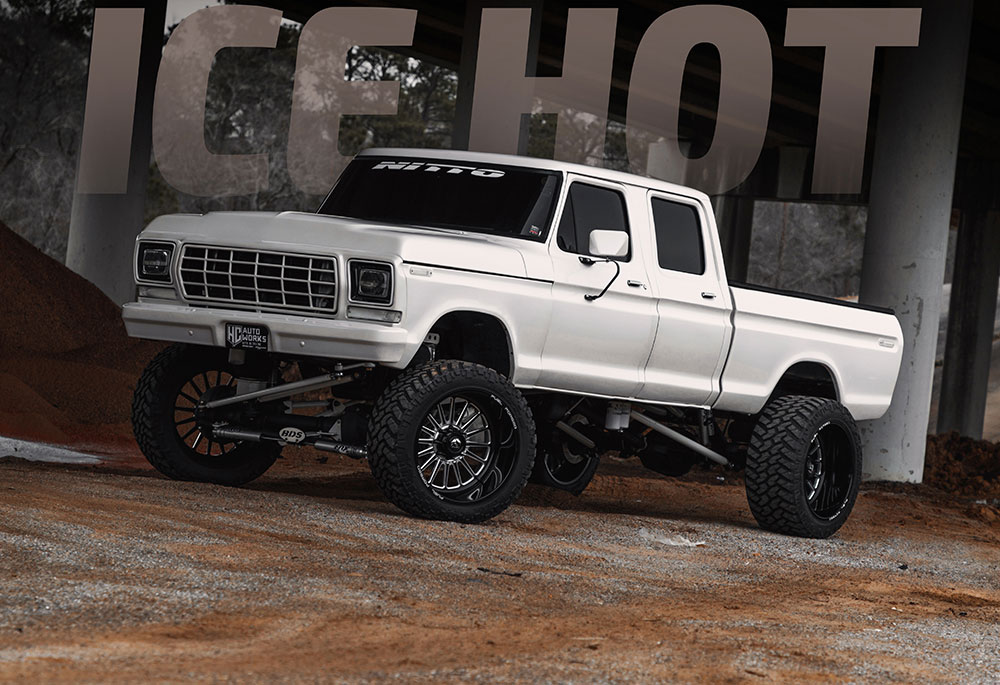
When you work in the automotive industry, it can take a lot to be impressed. After all, you’re surrounded by vehicles day in and day out, so you see A LOT of them up close and personal. Hunter Clark of Sturgis, Michigan, knows this feeling all too well. As the owner of HC Auto Works, an automotive detailing service, Hunter makes vehicles of all types look their best every day. So when he decided to build a 1979 Ford F250 truck for himself, he knew that it had to be unique, and it had to be perfect.
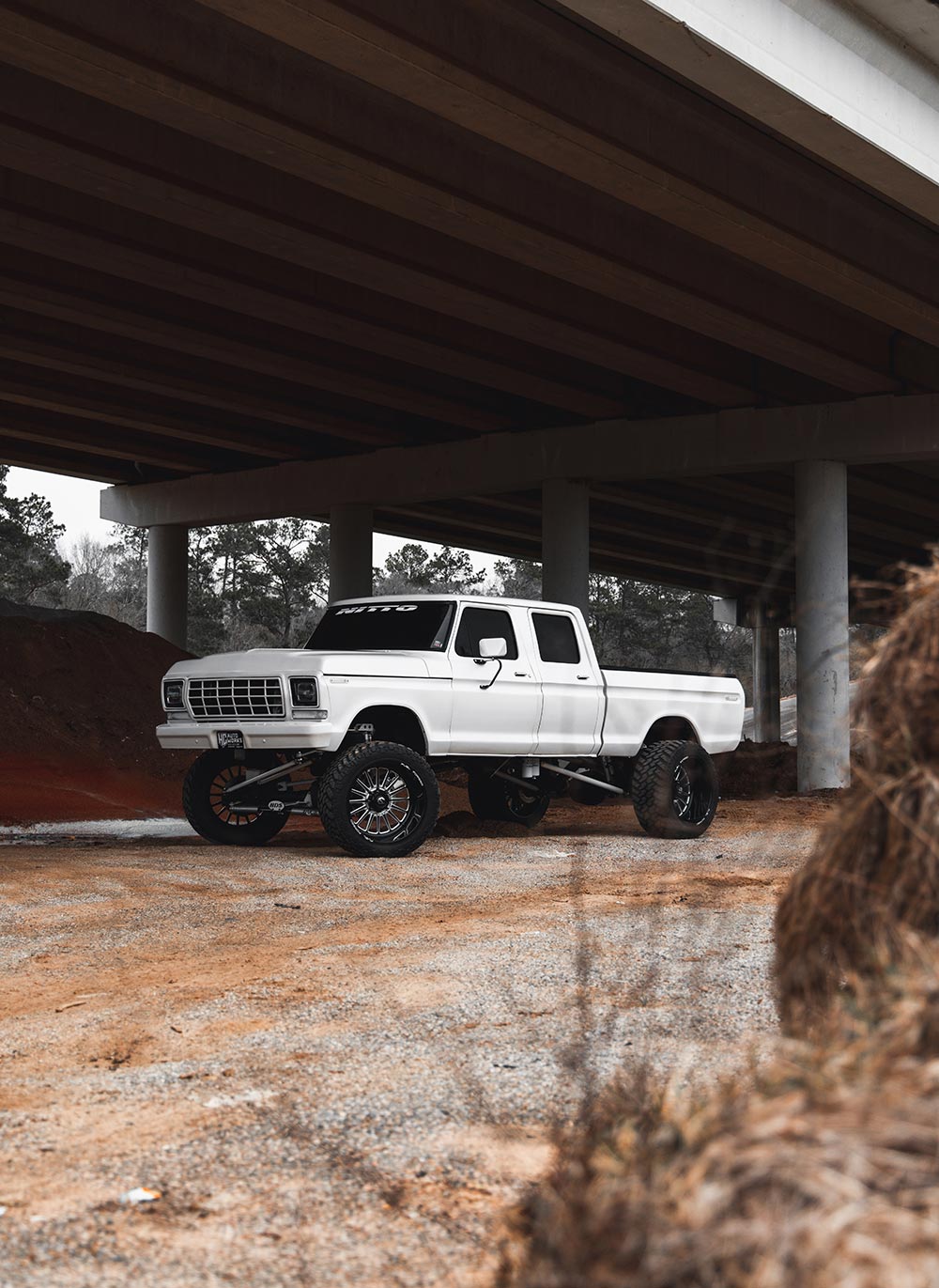
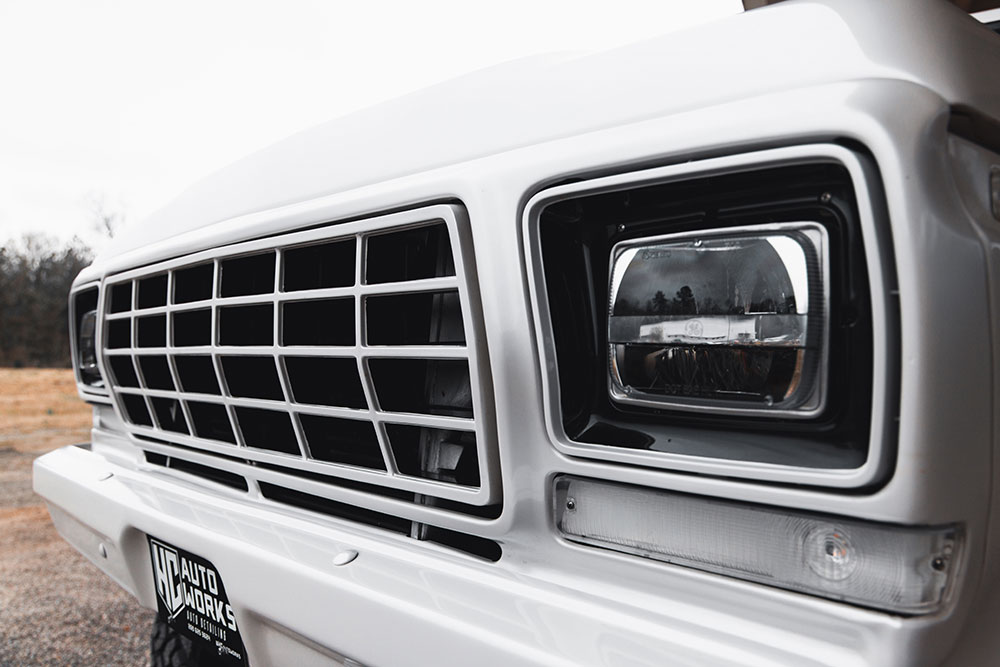 To that end, that also meant that the truck would have to be a bucket list ride for him since he’d be going all the way with the build, no expense being spared. It didn’t take long for Hunter to choose the perfect candidate: a 1979 Ford F250 crew cab. Hunter then set out on a four year journey to build one of the baddest dentside F-250s around, and as you can see by the photos: mission accomplished.
To that end, that also meant that the truck would have to be a bucket list ride for him since he’d be going all the way with the build, no expense being spared. It didn’t take long for Hunter to choose the perfect candidate: a 1979 Ford F250 crew cab. Hunter then set out on a four year journey to build one of the baddest dentside F-250s around, and as you can see by the photos: mission accomplished.
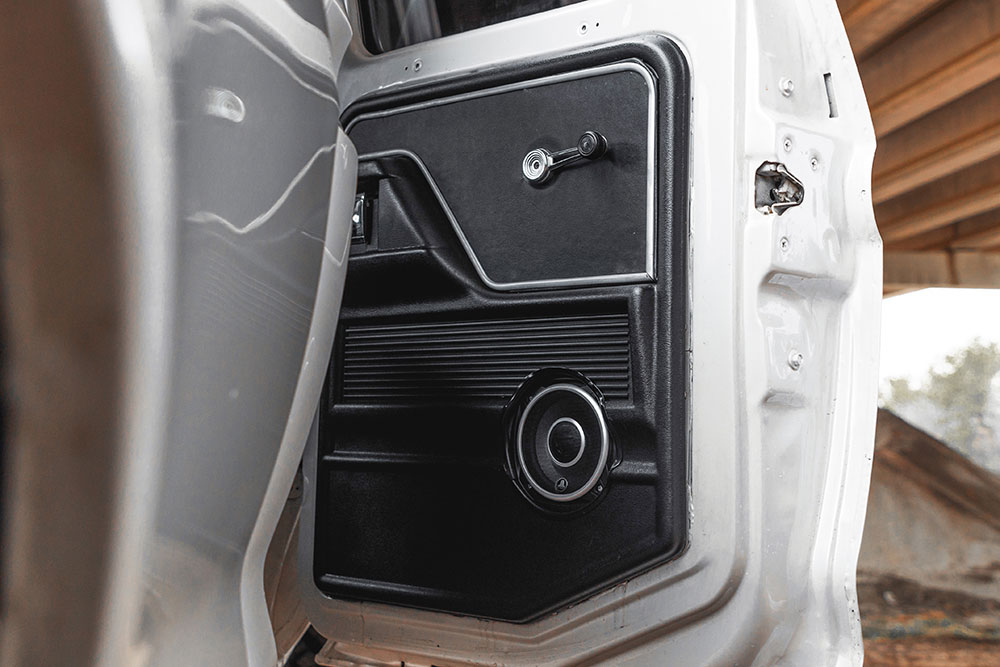
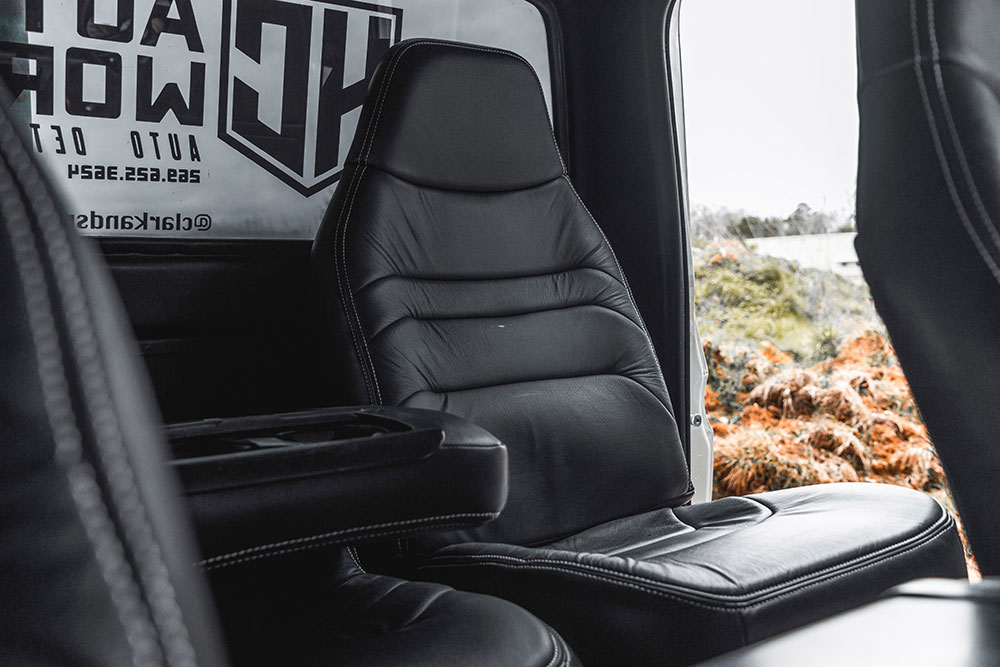 Pretty much any generation F-250 is formidable in its stock form, but the dentsides are somehow still the ones we tend to see the most of on-road and off, hauling everything from dirt bikes to horse trailers like it ain’t no thang. So, it’s no surprise that you’re likely to find any one of Ford’s bulletproof engines under the hood, from a 302 Windsor or Cleveland to a 460 385-series. But, that’s not how Hunter wanted to roll. He was looking for a lot more power, and massive amounts of torque, which is what diesel power is all about! A ‘97 12-valve 5.9L Cummins was just the ticket, and after being built up by Legendary Diesel Performance (including 62m and 75mm turbos) was dropped into the engine bay using C&S swap mounts and mated to a matching built ‘97 47RH automatic transmission.
Pretty much any generation F-250 is formidable in its stock form, but the dentsides are somehow still the ones we tend to see the most of on-road and off, hauling everything from dirt bikes to horse trailers like it ain’t no thang. So, it’s no surprise that you’re likely to find any one of Ford’s bulletproof engines under the hood, from a 302 Windsor or Cleveland to a 460 385-series. But, that’s not how Hunter wanted to roll. He was looking for a lot more power, and massive amounts of torque, which is what diesel power is all about! A ‘97 12-valve 5.9L Cummins was just the ticket, and after being built up by Legendary Diesel Performance (including 62m and 75mm turbos) was dropped into the engine bay using C&S swap mounts and mated to a matching built ‘97 47RH automatic transmission.
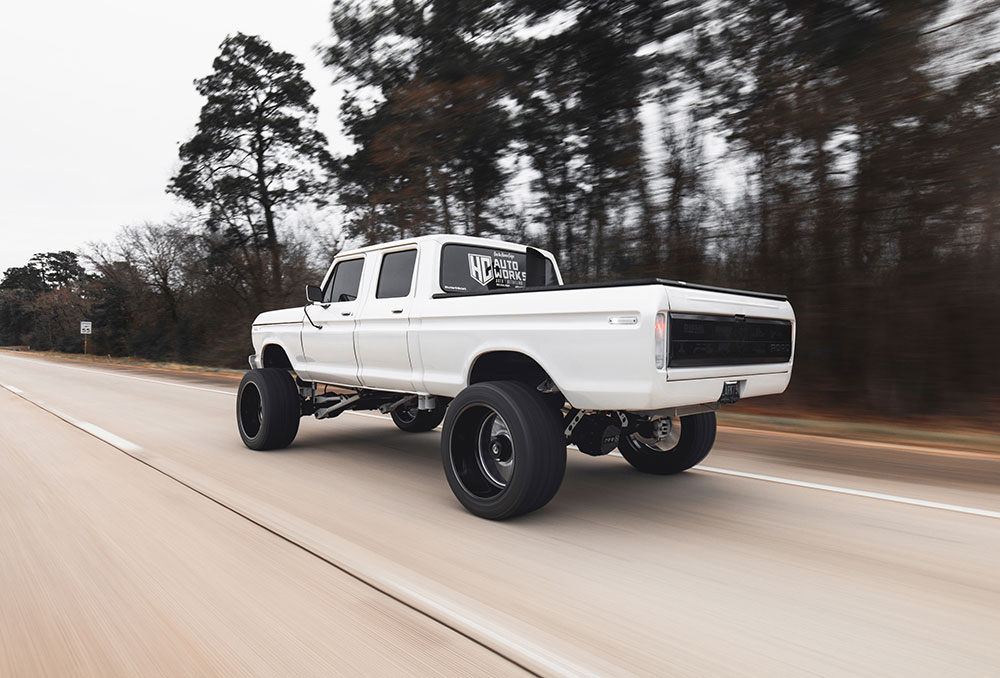
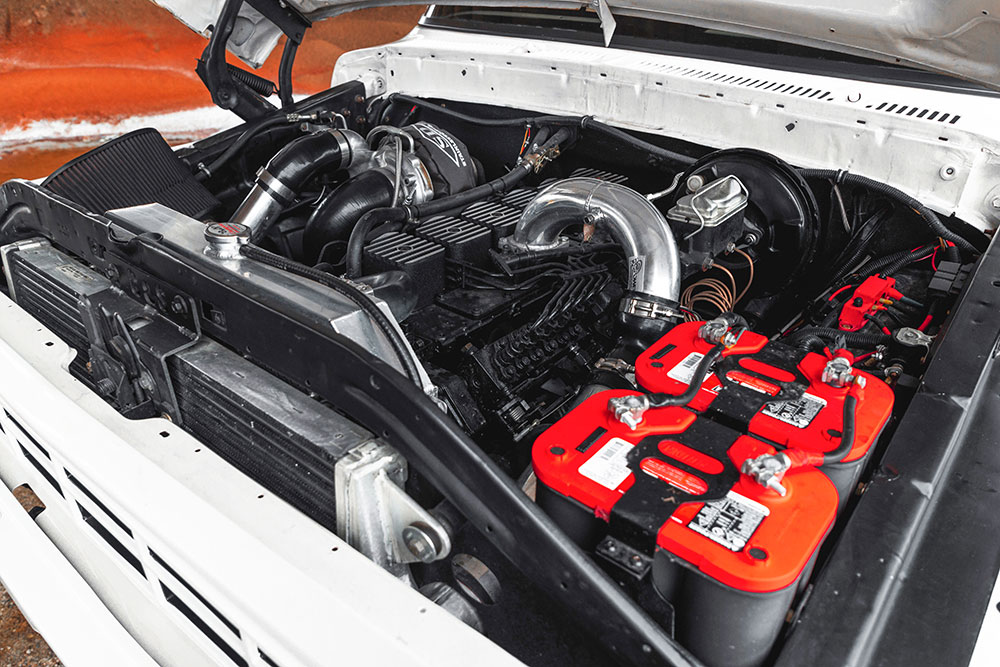 To send power to the front wheels, a divorced NP205 transfer case was bolted up, with an ‘05 F-250 Dana 60 axle attached to the chassis via a 3-link suspension. The same ‘05 F-250 also donated its 10.25-inch rear end and is located by a triangulated 4-link. Both ends are suspended by air springs and damped by Fox shocks for a fully adjustable ride, and allow plenty of room for the 375/40R24 Nitto Trail Grappler tires, which surround 24×14 Fuel FF75 forged wheels.
To send power to the front wheels, a divorced NP205 transfer case was bolted up, with an ‘05 F-250 Dana 60 axle attached to the chassis via a 3-link suspension. The same ‘05 F-250 also donated its 10.25-inch rear end and is located by a triangulated 4-link. Both ends are suspended by air springs and damped by Fox shocks for a fully adjustable ride, and allow plenty of room for the 375/40R24 Nitto Trail Grappler tires, which surround 24×14 Fuel FF75 forged wheels.
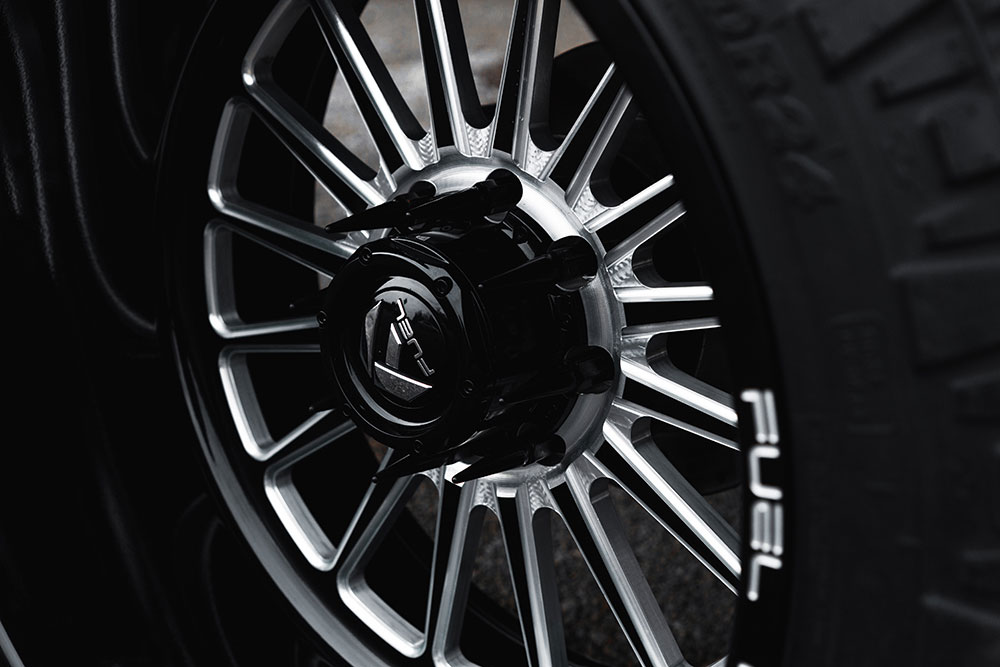
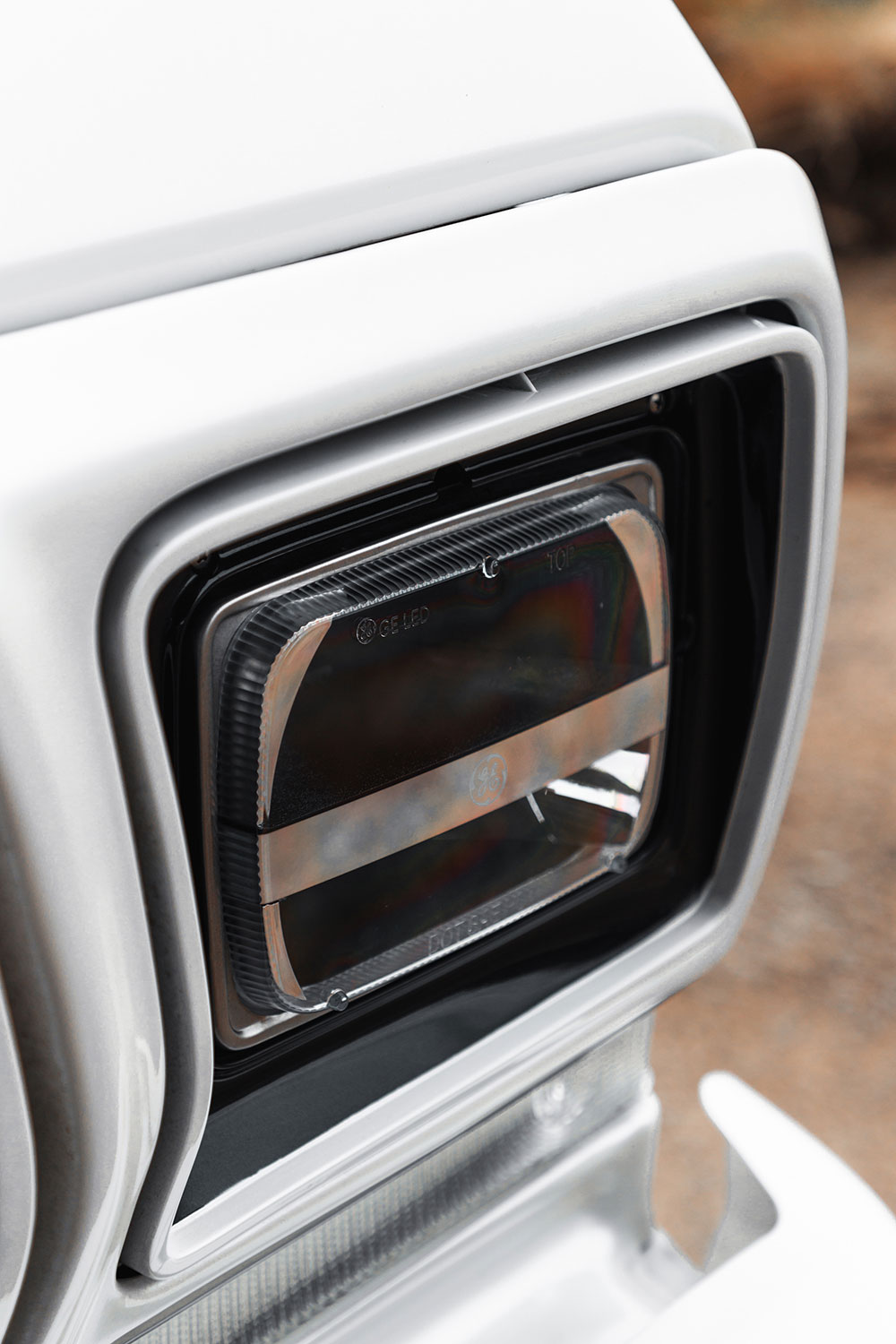 The rest of the exterior received just as much love, with the whole body getting debadged, a roll pan welded on, and the fuel door shaved off before Ford White Platinum paint was perfectly applied by Austin Runge. A total of 20 Assault rock lights illuminate the undercarriage.
The rest of the exterior received just as much love, with the whole body getting debadged, a roll pan welded on, and the fuel door shaved off before Ford White Platinum paint was perfectly applied by Austin Runge. A total of 20 Assault rock lights illuminate the undercarriage.
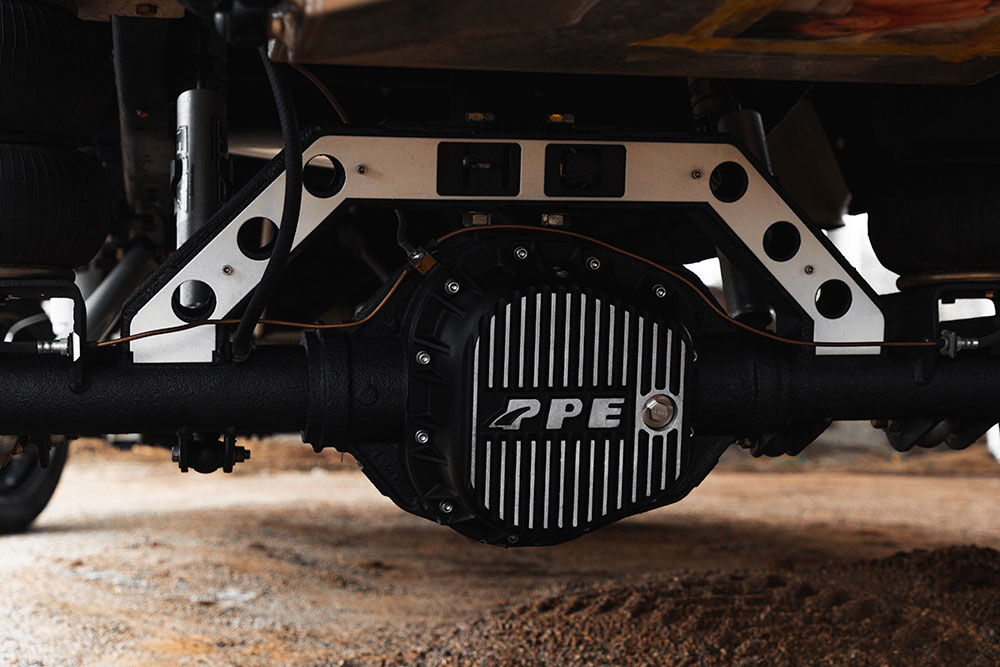 One of the most important aspects of the truck for Hunter was the interior, since that’s where he would be spending the most quality time. He found a couple sets of ‘96 F-250 40/20/40 seats, then covered them with fresh Katzkin leather, as well as the door panels and headliner. The rest of the cab was then fitted with a B&M ratchet shifter, hidden switches, a reverse camera setup, and a Pioneer touchscreen head unit.
One of the most important aspects of the truck for Hunter was the interior, since that’s where he would be spending the most quality time. He found a couple sets of ‘96 F-250 40/20/40 seats, then covered them with fresh Katzkin leather, as well as the door panels and headliner. The rest of the cab was then fitted with a B&M ratchet shifter, hidden switches, a reverse camera setup, and a Pioneer touchscreen head unit.
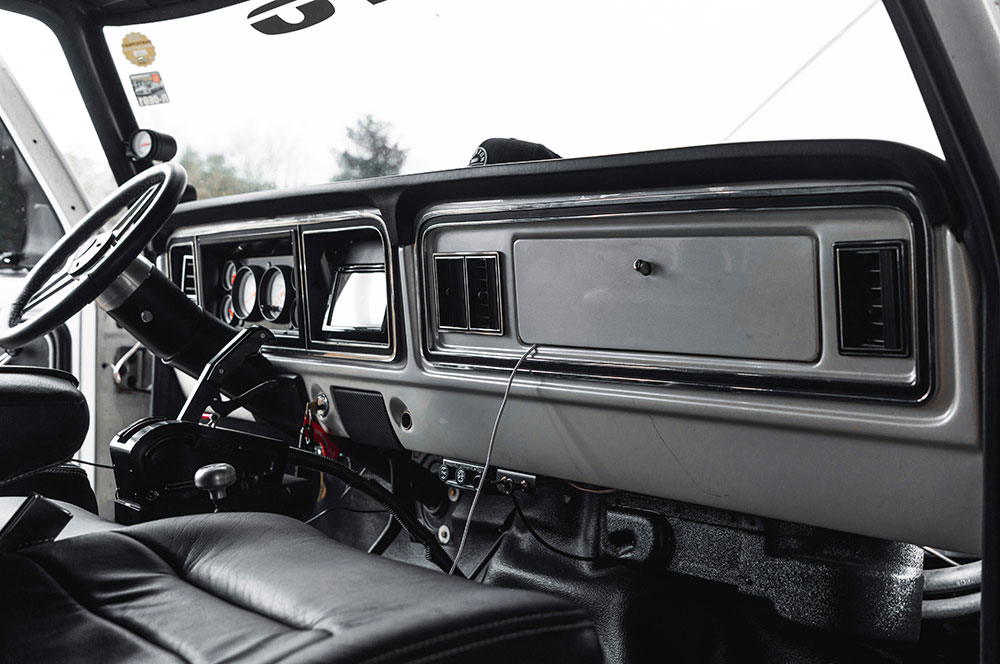
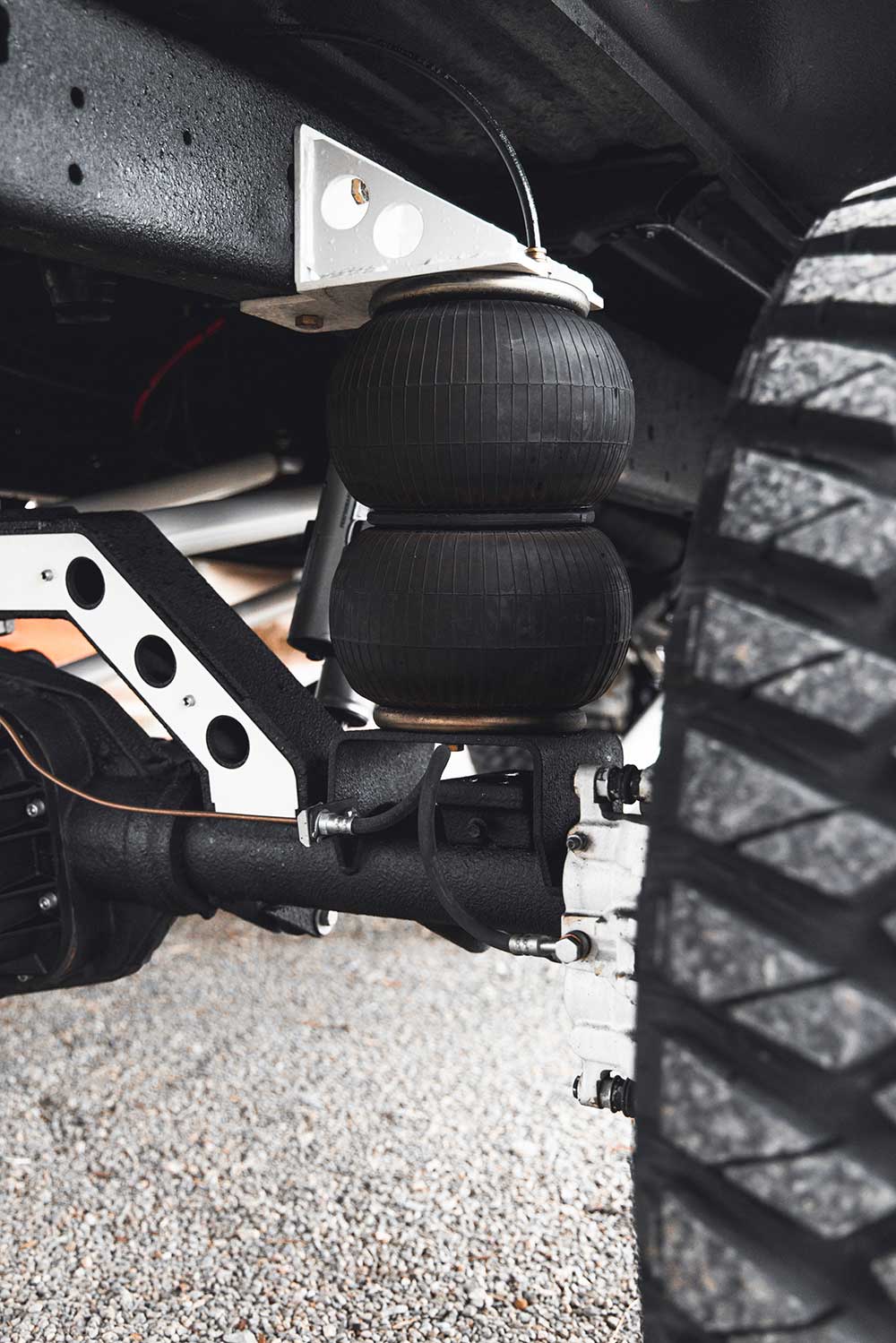 Since finishing the truck, Hunter has taken it to tons of events, from LST to Daytona Truck Meet, and even the Indy 4×4 Jamboree. He says that he’s proud that the F-250 turned out exactly the way he wanted it, which he attributed to taking his time and having a clear vision of how the truck should be built.
Since finishing the truck, Hunter has taken it to tons of events, from LST to Daytona Truck Meet, and even the Indy 4×4 Jamboree. He says that he’s proud that the F-250 turned out exactly the way he wanted it, which he attributed to taking his time and having a clear vision of how the truck should be built.
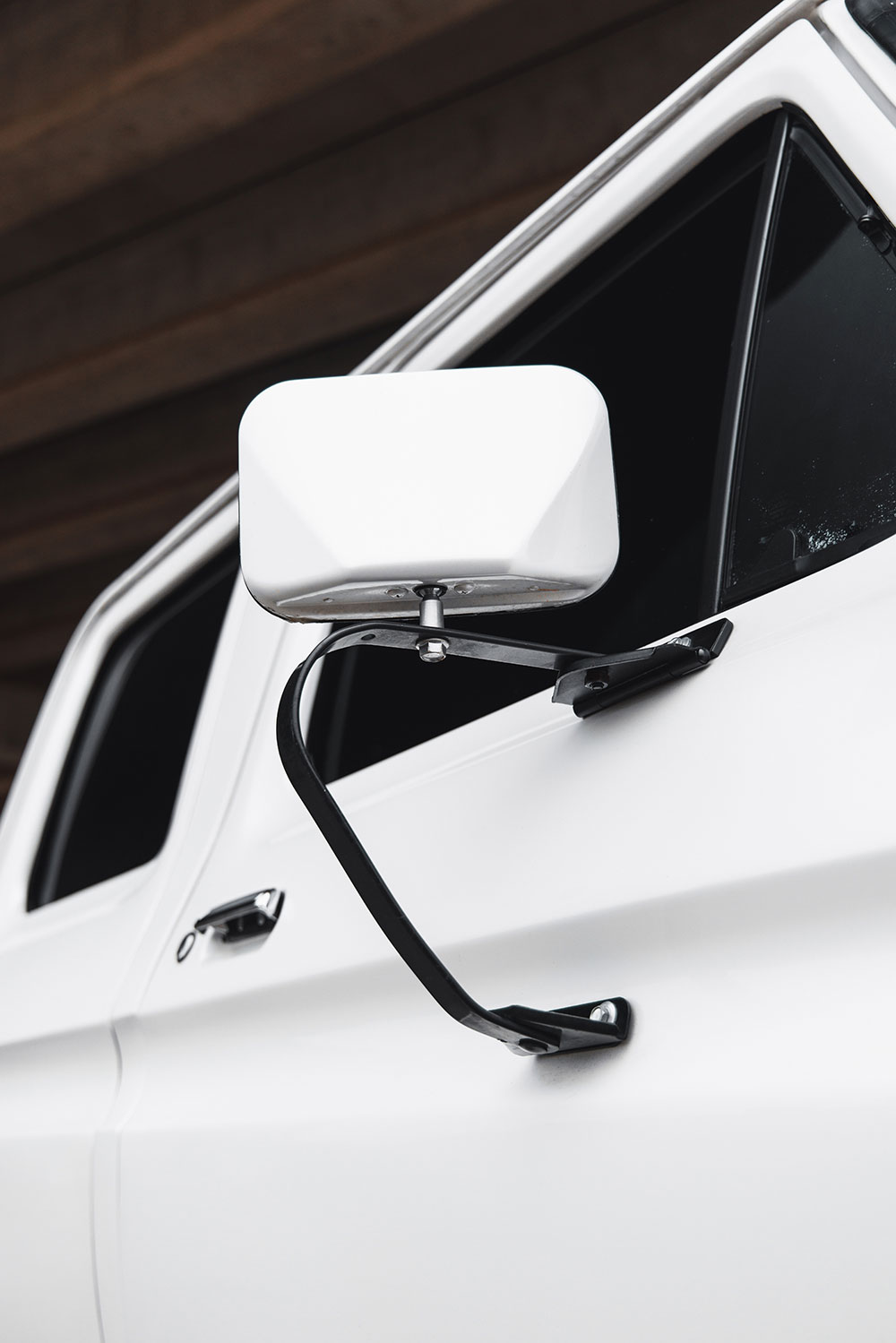
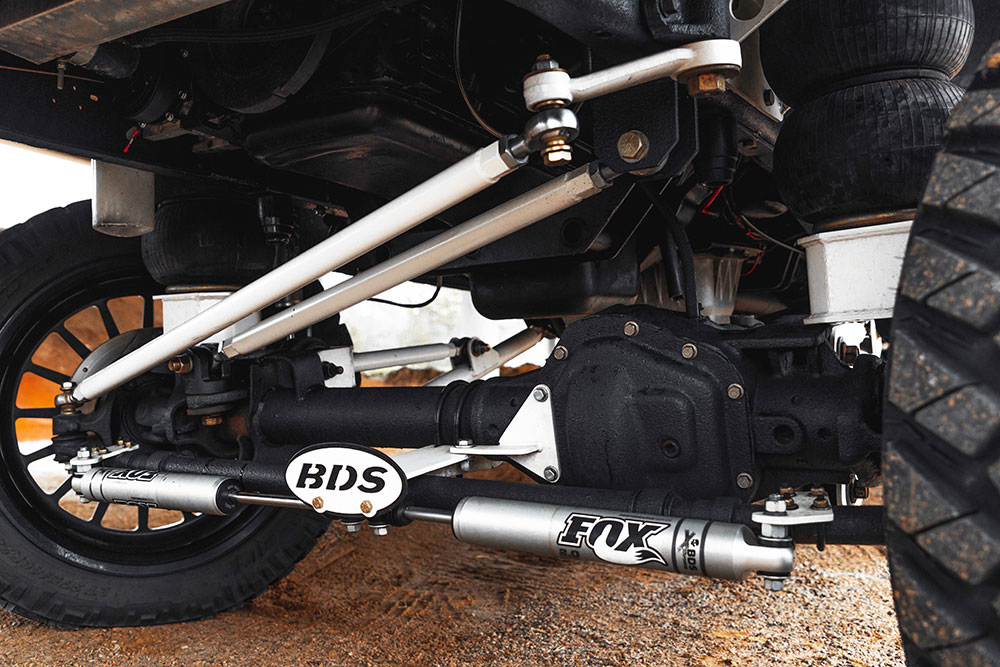 From what we hear, the truck may be for sale soon, so if you’ve got a decent chunk of change to spare you could try your luck and look him up!
From what we hear, the truck may be for sale soon, so if you’ve got a decent chunk of change to spare you could try your luck and look him up!
TECH SPECS
OWNER
Hunter Clark
Sturgis, MI
1979 Ford F250
Chassis & Suspension
Wheels & Tires
Engine & Drivetrain
Body & Paint
Interior & Stereo
What is the seller’s policy on driving classic cars long distances?
Driving classic cars long distances is generally discouraged due to several factors:
Recommendation: Instead of driving, we strongly advise shipping the vehicle using a reputable third-party service, such as uShip or Reliable Carriers. This approach ensures that the car arrives safely and prevents wear and tear from long-distance driving.
What Should Buyers Be Aware of Regarding the Condition and Maintenance of Classic Cars?
Buying a classic car is an investment that requires careful consideration. Here are some key points to keep in mind:
Owning a classic car can be incredibly rewarding, both emotionally and financially. However, prospective buyers must be prepared for the responsibilities that come with maintaining such vehicles. Awareness of rising costs, potential appreciation, and the need for diligent maintenance will ensure that your investment remains sound and enjoyable for years to come.
What are the operating hours for contacting the sales team?
To contact our sales team, please note the following hours:
Contact Number: 1-877-378-4679
Feel free to call during the designated times for any inquiries.
What is the policy regarding vehicle mileage information?
Understanding vehicle mileage is crucial for vintage car buyers. Our policy ensures transparency and accuracy whenever possible.
Owning a classic car is an investment. Here are some reasons why accurate mileage is key:
We strongly advise buyers to:
In summary, while we strive to provide accurate information, your diligence ensures the best investment decision.
What is included in the dealership processing fee?
What Does the Dealership Processing Fee Include?
When you purchase a vehicle from us, the dealership processing fee ensures a seamless and worry-free experience. For a nominal fee of $399, here’s what you get:
By covering these essential services, our processing fee assures a smooth transaction and peace of mind.
How Many Images and Videos Are Provided in Each Vehicle Listing?
In each vehicle listing, you can expect to find around 75 high-definition images. Additionally, we include an HD video to give you a comprehensive view of the vehicle. These visual aids ensure that you have a thorough understanding of the car’s condition and features before making any decisions.
What are the different types of restorations mentioned?
When it comes to restoring vintage cars, enthusiasts might have different interpretations of what “restoration” means. From simple touch-ups to extensive overhauls, knowing the different types of restorations can significantly impact a classic car’s value. Here are the main types of restorations you might encounter:
Each level of restoration serves a different purpose, whether you’re aiming to have a show-ready car or simply to enjoy a visually appealing vintage ride. Understanding these distinctions can help you make informed decisions when restoring or purchasing a classic vehicle.
What Are the Different Levels of Classic Car Restorations?
In the vintage car world, the term “restoration” can mean different things to different enthusiasts. Understanding these levels is crucial because they can significantly impact the value of a classic car. Here’s a breakdown of the primary levels of restoration:
A frame-off restoration is one of the most comprehensive methods. In this process, the body of the vehicle is completely removed from the frame. Here’s what it typically involves:
These restorations are usually extensive and quite costly, but they can bring a car back to like-new condition.
Similar to a frame-off restoration, a rotisserie restoration involves taking the vehicle apart completely. However, the body and frame are mounted on a rotisserie, allowing for 360-degree access. This facilitates:
These restorations are also extensive and costly but provide incredible results due to the detailed access a rotisserie offers.
For those looking for a less intensive and more budget-friendly option, a cosmetic or driver-quality restoration might be appropriate. This level typically focuses on:
While not as thorough as frame-off or rotisserie restorations, cosmetic restorations still enhance the car’s aesthetics and functionality, making it enjoyable to drive.
Within these levels, the quality of work can vary significantly. Restorations can range from amateur efforts done in home garages to high-dollar, professional concours-grade restorations. Additionally, classic cars are often rated on a universal 100-point scale:
By understanding these levels and the potential quality involved, consumers can make informed decisions about what kind of restoration meets their needs and how it will affect the vehicle’s value.
What Should Buyers Know About Classic Car Restorations?
When diving into the world of classic car restorations, it’s essential to grasp the varying degrees of restoration and how each level impacts value. Understanding these nuances ensures that buyers make informed decisions and appreciate the true worth of their investment.
Classic car restorations generally fall into three main categories:
Within these levels, the quality of work can vary widely:
A universal 100-point grading system is often used to assess the condition of classic cars:
Apart from the levels, the type of restoration also plays a crucial role in determining a classic car’s value:
Understanding the extent and quality of restorations, alongside the type of restoration performed, is vital for buyers. Each aspect influences the car’s authenticity, functionality, and ultimately, its value. By knowing what level and type of restoration best fit their needs and investment goals, buyers can navigate the classic car market more effectively.
What types of vintage vehicles does the seller specialize in?
What Types of Vintage Vehicles Do We Specialize In?
At our shop, we take pride in offering a diverse collection of vintage vehicles. Our specialties include:
Whether you’re looking for rugged off-roaders or classic workhorses, we have an impressive selection. Our lineup features renowned names like Pinzgauer, Unimog, Land Cruiser, and Jeep Willys.
Cruising in style has never been easier. We house a variety of American legends, from the elegant Cadillac Biarritzto the iconic Chevy Belair. Expect to find timeless classics that exude charm and sophistication.
Feel the power and relive the glory days with our assortment of muscle cars. Discover high-performance machines ranging from Camaros and Mustangs to Challengers and Corvettes. Each car is sure to ignite your passion for speed.
For those who appreciate the elegance of European engineering, our collection includes timeless beauties like the Porsche 356, Mercedes Benz, and the classic Volkswagen Microbus. These vehicles represent the pinnacle of European design and performance.
Explore our showroom and find the vintage vehicle that speaks to you. Whether it’s the ruggedness of a classic 4×4, the cool charm of an American cruiser, the raw power of a muscle car, or the refined elegance of a European classic, we have something for every enthusiast.
Does the seller assist with international shipping?
Absolutely, we offer comprehensive support for international shipping. Whether you’re in Canada, Europe, Australia, New Zealand, Japan, South America, or the Middle East, we’ve successfully delivered vehicles around the globe. We’re here to make sure your vehicle reaches your home port without any hassle.
Our goal is to ensure a smooth and stress-free shipping process for all our international customers.
What shipping options are available for the vehicle?
When it comes to transporting your newly purchased vehicle, you have several options to ensure its safe and efficient delivery.
We offer comprehensive in-house shipping coordination. Our team will manage all the logistics, providing you with continuous updates from point A to point B. This one-stop solution allows for a hassle-free experience, ensuring you are aware of your vehicle’s status at all times.
For those who want to offer maximum protection for their investment, enclosed shipping is highly recommended. This method shields your vehicle from external elements and potential damage during transit. It is an ideal choice for classic cars, luxury vehicles, or any automobile you wish to keep in pristine condition.
We work with reputable carriers who are fully licensed, insured, and bonded. Using trusted services like Central Dispatch ensures that your vehicle is handled by professionals who take the utmost care in transport.
While every effort is made to ensure your vehicle arrives in perfect condition, it’s important to note that minor damages can occur during shipment. Although we cannot be held liable for such instances, our careful selection of reliable carriers minimizes these risks.
Our experience extends far beyond domestic boundaries; we have successfully shipped vehicles worldwide.
We provide support for transporting your vehicle to virtually any home port across the globe. Additionally, we assist with all necessary export and import documentation to streamline the process.
For international buyers, we recommend using these well-established shipping services:
Whether shipping domestically or internationally, we strive to provide the highest level of service, ensuring a smooth and secure delivery of your vehicle.
Are Vehicle Inspections Encouraged Before Purchase?
We strongly suggest that potential buyers conduct thorough vehicle inspections before making a purchase. Our team performs a comprehensive one-hour, 30-point inspection to identify any detectable issues. However, it’s important to note that our inspection may not catch all potential defects or problems.
Feel free to visit our showroom in Denver, CO. We’d be thrilled to meet you and assist you through every step of the buying process.
What is the policy on non-refundable deposits?
To reserve a vehicle, a deposit of $500 is required. This deposit ensures the vehicle is held exclusively for you for a period of 72 hours, allowing you time to complete the final payment.
We strongly advise that any inspections be done prior to placing a deposit. This ensures you’re fully satisfied with the vehicle before committing to the reservation fee.
Taking these steps helps protect your investment and ensures a smooth purchase process.
How Much is the Deposit to Hold a Vehicle?
To secure a vehicle, a deposit of $500 is required. This deposit ensures that the vehicle remains reserved for you for a period of 72 hours, giving you enough time to complete the final payment.
What Financing Options Are Available for Purchasing the Vehicle?
When you’re ready to purchase your vehicle, several financing options are available to help you through the process:
To expedite the financing process, please follow these steps:
For ease of reference, here are the contact numbers for the respective financial institutions:
By choosing the right financing option and following these steps, you can make your vehicle purchase smooth and efficient.
How is the rarity and value of collectible vintage vehicles described?
The allure of collectible vintage vehicles lies in their growing rarity and increasing value. As the availability of these classic cars dwindles—no new models are being produced—their scarcity intensifies by the day. This rarity not only makes them highly sought after but also transforms them into valuable investments.
Numerous articles and auction results have documented the consistent appreciation of these vehicles. Platforms such as Hagerty and RM Sotheby’s frequently report on the skyrocketing prices and increasing demand for well-maintained classic cars, reinforcing their status as sound investments.
Does the seller inspect the engine size or compression?
We do not conduct detailed inspections of engine size or compression. The information we have comes from previous owners and has not been independently verified.
Taking these steps ensures you have all the information you need before making a purchase.
What is the estimated monthly payment for the vehicle?
Are you curious about the monthly cost for your new vehicle? Based on a 10% down payment and a financing term of 72 months, the estimated monthly payment would be approximately $444.
This estimate is designed to give you a clear understanding of what to expect each month, making it easier to budget and plan for your purchase.
Is a Carfax or Autocheck history report available for the vehicle?
Certainly! Here’s the revised content to answer the specific question:
Classic vehicles, especially those built before 1981, generally do not come with history reports like Carfax or Autocheck. These reports became prevalent with newer vehicles, and the systems to track such data often didn’t exist for older cars.
For vehicles from 1981 and newer, there might be an availability for Carfax or Autocheck reports, given that the systems started recording information around that time. However, for many classic cars, comprehensive documentation including mileage, repairs, and past ownership often isn’t available.
If you’re looking at a classic vehicle, keep in mind that these types of cars are sold “as-is” and often lack detailed history records. Therefore, we recommend considering third-party inspections or appraisals for a thorough understanding of the vehicle’s condition.
This rephrased answer directly addresses the availability of history reports and explains the context for both pre-1981 and post-1981 vehicles without referencing specific entities.
Is there a mechanical inspection report available for the 1979 Ford F250 CREW CAB?
Yes, there is a comprehensive mechanical inspection report available for the 1979 Ford F250 CREW CAB. The report details a thorough 30-point inspection, covering essential areas of the vehicle to ensure its mechanical integrity and overall condition.
You can view the full inspection report in the photo gallery section. This provides a transparent and detailed insight into the vehicle’s mechanical status.
How many miles are on the 1979 Ford F250 CREW CAB?
The 1979 Ford F250 CREW CAB has 53,382 miles on the odometer.
Are there any cosmetic imperfections mentioned for the vehicle?
The rest of the exterior received just as much love, with the whole body getting debadged, a roll pan welded on, and the fuel door shaved off before Ford White Platinum paint was perfectly applied by Austin Runge. A total of 20 Assault rock lights illuminate the undercarriage.
While the paint job is near perfection, it’s important to note that there are a few chips and imperfections (see detailed pictures). These minor flaws add character and remind you that this vehicle has a history, yet they don’t detract from the overall stunning appearance and meticulous craftsmanship.
The fusion of enhancements and minor imperfections offers a unique blend of classic charm and modern flair, ensuring this vehicle stands out whether it’s on the road or displayed at a show.
How many miles does the new 460 motor have on the 1979 Ford F250?
The newly installed 460 motor in the 1979 Ford F250 has approximately 6,000 miles on it.
What maintenance or repairs does the 1979 Ford F250 Crew Cab currently need?
The 1979 Ford F250 Crew Cab currently requires maintenance on its front end, specifically the replacement of the ball joints. The necessary parts for this repair are already available, ensuring that the work can be carried out without delay.
What are the key features and specifications of the 1979 Ford F250 Crew Cab 4×4?
OWNER
Hunter Clark
Sturgis, MI
1979 Ford F250 Crew Cab 4×4
Chassis & Suspension
Wheels & Tires
This classic truck boasts a 4-inch lift complemented by new shocks, enhancing its rugged off-road capability. It rides on 36×13.50×16 Super Swampers with 75% tread, ensuring robust traction both on and off the beaten path. The tinted windows and new windshield add a touch of modern comfort and style.
Engine & Drivetrain
Under the hood, you’ll find a new 460 motor with approximately 6,000 miles paired with a rebuilt C6 transmission. This setup promises reliability and performance, whether you’re cruising the highway or tackling tough terrain. The truck is also equipped with Flowmaster exhaust and billet differential covers, offering a throaty growl and enhanced style.
Body & Paint
The exterior retains its 1996 paint job, which still waxes up nicely despite some scratches and chips. Having spent most of its life in Southern California before relocating to the Midwest, the truck remains free from bondo or collision damage, presenting a clean and presentable appearance.
Interior & Stereo
The interior is in excellent condition, with all components intact. Recently updated to R35, the air conditioning blows cold, a feature not to be overlooked. While everything functions as it should, the radio requires a main fuse. It also includes Fosgate speakers for an upgraded audio experience.
This 1979 Ford F250 Crew Cab 4×4 combines classic charm with modern enhancements, making it a reliable and stylish choice for any truck enthusiast. With its rich history and robust performance, it’s ready for both daily drives and adventurous outings.
How long has the current owner had the vehicle and where has it been located?
The current owner has had the truck since 1994, and it was located in Southern California until two years ago when it moved to the Midwest.
Are there any immediate maintenance needs?
The front ball joints need replacing, and the parts are available.
Is the air conditioning functional and updated?
Yes, the air conditioning has been updated to R35 and blows cold.
What is the condition of the interior?
The interior is in nice shape and is complete.
What is the condition of the paint and body?
The paint was applied in 1996 and, despite some scratches and chips, remains in a presentable condition.
What type of lift does the truck have?
The truck is fitted with a 4-inch lift and new shocks.
What are the tire specifications and their current condition?
It features 36×13.50×16 Super Swampers tires, with 75% tread remaining.
What is the condition of the transmission?
The vehicle has a rebuilt C6 transmission that shares the same mileage as the engine.
What is the engine configuration and its current mileage?
The truck is equipped with a new 460 motor, which has approximately 6,000 miles on it.
What is the condition of the paint and body of the 1979 Ford F250 Crew Cab?
The rest of the exterior received just as much love, with the whole body getting debadged, a roll pan welded on, and the fuel door shaved off before Ford White Platinum paint was perfectly applied by Austin Runge. A total of 20 Assault rock lights illuminate the undercarriage.
While the paint job is near perfection, it’s important to note that there are a few chips and imperfections (see detailed pictures). These minor flaws add character and remind you that this vehicle has a history, yet they don’t detract from the overall stunning appearance and meticulous craftsmanship.
Originally painted in 1996, the truck’s exterior shows signs of its storied past with some scratches and paint chips. Having spent most of its life basking under the Southern California sun before moving to the Midwest two years ago, the paint retains a remarkable resilience and still waxes up beautifully, projecting a presentable and polished look. Remarkably, the body boasts no bondo or collision damage, preserving its authentic structure.
The fusion of enhancements and minor imperfections offers a unique blend of classic charm and modern flair, ensuring this vehicle stands out whether it’s on the road or displayed at a show.
How does the paint respond to maintenance?
Waxing the paint brings it to a presentable condition, indicating it maintains a good appearance with proper care.
How has the vehicle’s location history affected its condition?
Having spent most of its life in Southern California before moving to the Midwest two years ago, the truck’s condition is influenced by these geographic factors.
Is there any bondo or collision damage?
There is no bondo or collision damage present on the vehicle.
What is the general condition of the paint?
The paint has some scratches and chips.
When was the vehicle last painted?
The vehicle received its paint job in 1996.
What are the details of the audio system in the 1979 Ford F250 Crew Cab?
The audio system offers a blend of modern convenience and classic appeal. While the Pioneer touchscreen head unit provides easy control over your music and connectivity needs, the radio system does require a main fuse to function fully. Complementing the head unit, the JL Audio speakers ensure a crisp sound experience, adding to the vehicle’s entertainment capabilities.
What brand of speakers is installed in the vehicle?
Speakers from Fosgate equip the vehicle.
What is the current condition of the radio?
The radio is currently not fully operational as it requires a replacement for the main fuse.
Share Link